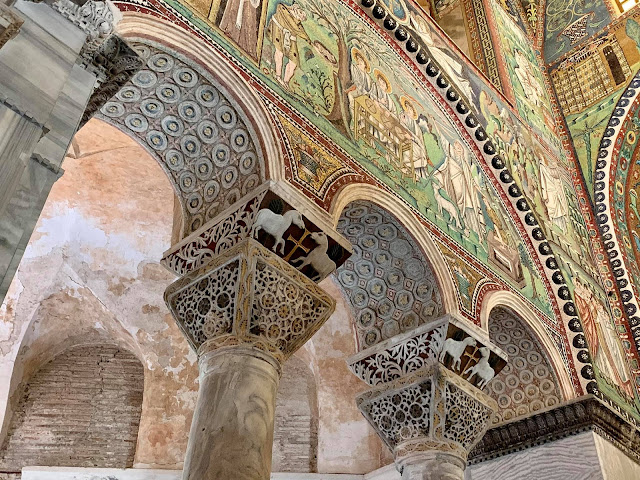Recently, our friend and colleague, Nicola de Grandi, a native son of Milan, published some excellent photos of a trip he took to San Vitale in Ravenna -- one of the most stunning extant examples of Italo-Byzantine architecture in existence. The church dates to the sixth century and includes an incredible array of mosaics. Construction on the basilica began in the year 526 and concluded in the year 547. The church has an octagonal plan, rather than the more typical basilica model, combining both Roman and Byzantine elements.
The apse mosaic depicts St. Vitalis of Milan, the martyr for whom the church is named, an angel, Christ (handing St. Vitalis the crown of martyrdom) another angel and the Bishop Ecclesius -- who commissioned the construction of the basilica.
Two of the most famous mosaics are found flanking the windows beneath the apse; the one depicting the Emperor Justinian (clad in imperial robes of Tyrian purple) with his retinue and St. Maximianus (the bishop who completed construction of the basilica) with two of his deacons. The Emperor appears to be holding a Eucharistic vessel for the offerings of bread.
The second mosaic depicts the Empress Theodora with her retinue. The empress is depicted holding a Eucharistic vessel to hold the wine.
This leads us down to the mosaics found to either side of the altar.
Found at the upper levels are symbols of the four evangelists. Beneath these are typological scenes taken from the Old Testament that foreshadow the sacrifice of Christ and the Christian liturgy in the persons of Abraham and the sacrifice of Isaac as well as offering of bread and wine by Melchizedek.
By way of some further architectural details, it is worth noting that the sanctuary is not in precisely original configuration. For example, here are some details of the transennae which were originally within the basilica, thought to have likely separated the presbytery from the rest of the church.
By way of one further addendum to the incredible photographic details that Nicola has provided for us, it is worth noting that another high altar, more typical of the counter-reformation period, had been introduced to San Vitale and a partition had been constructed in front of the synthronon. This arrangement can be seen here in this photograph (left) from the end of the 19th century and a painting (right) from 1913.
One might also note the balustradres which had been added above.
All of these later additions were removed sometime in the early part of the 20th century with the baroque altar by Toschini replaced by the current one which was apparently recomposed of alabaster components coming from the Mausoleum of Galla Placidia in Ravenna.
 |
| The apse |
Stepping back one gets a fuller sense of the full splendour of the mosaic programme of the entire sanctuary.
Two of the most famous mosaics are found flanking the windows beneath the apse; the one depicting the Emperor Justinian (clad in imperial robes of Tyrian purple) with his retinue and St. Maximianus (the bishop who completed construction of the basilica) with two of his deacons. The Emperor appears to be holding a Eucharistic vessel for the offerings of bread.
 |
| One will note that one of the deacons holds a thurible (censer) in its more ancient form without a top; a feature still today of the Ambrosian rite. |
The second mosaic depicts the Empress Theodora with her retinue. The empress is depicted holding a Eucharistic vessel to hold the wine.
Crowning the sanctuary are a series of decorative mosaics that show natural elements along with four angels holding up the symbol of the Lamb of God.
At the threshold where the sanctuary meets the nave, we find images of Christ surrounded by medallions depicting the Twelve Apostles.
Aside from the figurative mosaics it is worth taking a moment to look at some of the geometric designs found throughout. One will also note here the lambs shown facing the cross on the capitals of the marble columns.
Of course, all of this splendour ultimately leads us down toward the central focal point of any church, the altar. The altar, like the capitals above, depict a Cross faced by two lambs. (More on this altar at the end of this article.)
Behind the high altar is the synthronon where the clerics would be seated.
By way of some further architectural details, it is worth noting that the sanctuary is not in precisely original configuration. For example, here are some details of the transennae which were originally within the basilica, thought to have likely separated the presbytery from the rest of the church.
One might also note the balustradres which had been added above.
All of these later additions were removed sometime in the early part of the 20th century with the baroque altar by Toschini replaced by the current one which was apparently recomposed of alabaster components coming from the Mausoleum of Galla Placidia in Ravenna.
This painting from 1913 shows a depiction envisioning a more antique arrangement of the altar along with the transennae.































